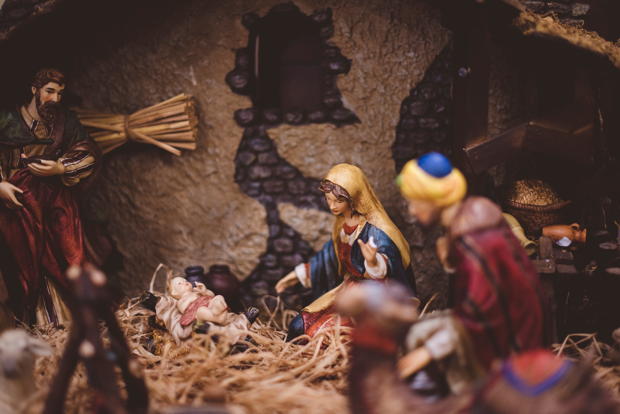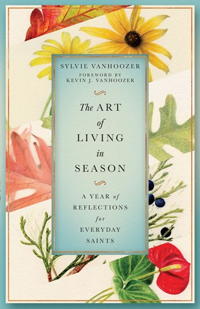
As we enter the season of Christmas, we're pleased to share an excerpt from the beginning of The Art of Living in Season: A Year of Reflections for Everyday Saints. In this volume, writer Sylvie Vanhoozer describes the traditional Provençal crèche of her childhood, exploring the ways this simple Advent tradition opened the way for spiritual growth the whole year long. If you find yourself intrigued by this exploration, check out her book at InterVarsity Press.
adapted from chapter one:
In the land of my ancestors, Advent is when people bring their precious seasonal figurines out of storage, not forgetting the miniature barn with its stone walls and red roof, seemingly taken straight out of the Provençal countryside. According to the ancient carols, Advent marks the season when the shepherds went on their peculiar pilgrimage to Bethlehem. In similar fashion, and in a way that is entirely in keeping with the season, another “holy pilgrimage” starts, this time with real people. Children, parents, and grandparents ramble into the quiet hills to gather material with which to decorate the manger scene. This walk is so special it even has its own name: La promenade de l’Avent (Advent walk).
By gathering native plants, moss, twigs, and so forth to provide a landscape for the manger scene, we root the crèche, and Jesus himself, in our terroir, our own patch of earth—the same earth, in fact, from which the santons figurines themselves were made, rendering the entire endeavor remarkably organic (Terre, the French word for “earth,” gives us the term terroir—local earth). The Advent walk brings plants and people, and a special season of the church year, together in an intimate, unique, and interrelated way.
 During these Advent walks, the elders speak softly to the young ones, initiating them into the deep mysteries of their storied place. Thyme is a “manger herb” because, according to legend, Joseph gathered grass and hay from the roadside with which to line the manger and, as soon as the baby’s head touched the manger, the grass turned into fragrant herbs—one of which was thyme. Children learn to identify the native thyme by smell when they rub it between their fingers. They watch in wonder as the thyme sprigs they gathered, inserted into the manger scene, transform into olive trees like the ones that dot their land. They learn that the juniper they collected preserves the scent of the hills and stays green in the crèche throughout the season. Each plant that makes its way into the scenery of the crèche is an integral part of the soil in which the children themselves have their own roots. The Advent walk helps inoculate them from what Wendell Berry calls the “characteristic diseases” of the century, namely, “the suspicion that they would be greatly improved if they were someplace else” (Wendell Berry, Fidelity, 20).
During these Advent walks, the elders speak softly to the young ones, initiating them into the deep mysteries of their storied place. Thyme is a “manger herb” because, according to legend, Joseph gathered grass and hay from the roadside with which to line the manger and, as soon as the baby’s head touched the manger, the grass turned into fragrant herbs—one of which was thyme. Children learn to identify the native thyme by smell when they rub it between their fingers. They watch in wonder as the thyme sprigs they gathered, inserted into the manger scene, transform into olive trees like the ones that dot their land. They learn that the juniper they collected preserves the scent of the hills and stays green in the crèche throughout the season. Each plant that makes its way into the scenery of the crèche is an integral part of the soil in which the children themselves have their own roots. The Advent walk helps inoculate them from what Wendell Berry calls the “characteristic diseases” of the century, namely, “the suspicion that they would be greatly improved if they were someplace else” (Wendell Berry, Fidelity, 20).
Upon their return home, young and old gather around the crèche and deck it out with their local treasures, re-creating a model version of their homeland with the herbs and scents they know so well. Each person has something to place in the scene, a small gift that, in a way, hints at the season of giving ahead. One may even catch a glimpse of a season further ahead in the story, when individual santons will become a fellowship of saints, sharing the gifts with one another they have been given by their risen Lord. With a little imagination, one might say that what ultimately grows out of the crèche gathering is a local church.
Our Advent walk is approaching the threshold of Christmas. In the words of the angel who opens one of the pastorales: “The Mistral [a strong cold wind from the north] who is a friend of the Good Lord, decided to prepare the stage by cleansing the sky that night, leaving not a single cloud, so that every star might shine brightly on God’s little one” (Yvan Audouard, La Pastorale des Santons de Provence, 3 [my translation]). It is a beautiful thought, nature’s way of preparing for a special season. The whole of creation, which has been watching and waiting, now welcomes the child Christ, just as the shepherd-poet David had said: “The heavens declare the glory of God, / and the sky above proclaims his handiwork” (Psalm 19:1). Now, the Christmas stage is set. The house is ready. The Guest may enter!
What’s an Everyday Saint to Do?
The shepherds in the old carols faced dark mountain paths, biting cold, little food, and the prospect of brigands taking what little they had, yet they continued to search for the child Christ until they found him in a barnyard, lying between a cow and donkey. A contemporary everyday saint might well ask, “What dark paths will I have to take, and what hidden dangers and unknown assailants will I meet on my way to Christ?”
Everyday saints, shepherds or not, should know the seasons of the place where they are planted. They should go on quiet Advent walks, whether in hills, through prairies, or along riverbanks—anywhere away from the distractions of a stressful world, crowded shops, and hectic schedules that tempt them to rush to Christmas before its due season. The art of living in Advent involves remembering: ’tis not yet the season (of Christmas). Everyday saints who pay attention to the seasons will use Advent to prepare inwardly the way of the Lord, pondering in their hearts, like Mary, the mystery of the one who came down from heaven to be here—not Bethlehem (or Provence), but here: let it be to me, here, according to your word (Luke 1:38).
What does this season of Advent really mean for me? Much as I love my crèche, Advent is about more than searching the hills for herbs to adorn a model manger. The real art of living in the season of Advent is about learning how to welcome Jesus in my place this Christmas, and in the coming year—and not just in the “official” manger scene, but in all the scenes of my everyday life: home, neighborhood, workplace, church, and heart. Everyday saints need time to prepare a fitting welcome for their Lord. This is the reason for the Advent season: to watch and wait, in solitude and attentiveness, for God’s active presence, so that as we make our own pilgrimage we can say with David:
I will not give sleep to my eyes
or slumber to my eyelids,
until I find a place for the Lord,
a dwelling place for the Mighty One of Jacob.
(Psalm 132:4-5)
Adapted from The Art of Living in Season by Sylvie Vanhoozer. ©2024 Sylvie Vanhoozer. Used by permission of InterVarsity Press. www.ivpress.com.
Photo by Ben White on StockSnap